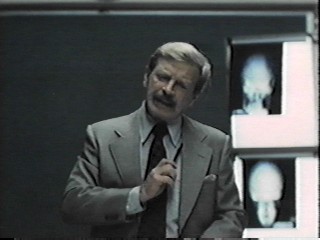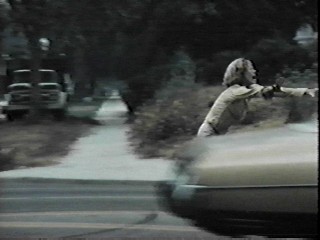
|
|
|
|
|
|
|
|
|
|
|
|
|
(1977) Director: Michael
Pataki
If nothing else, Mansion Of The Doomed can
at least claim that it occasionally provides viewers the feeling that
they
have been taken back in time to the glory days of the drive-in. Now, I
never got to actually experience the true drive-in experience, because
I was too young to drive when my town's drive-in was running, and the
few
times I actually got to go there was when my parents exposed me to
movies
like The Muppet Movie and
This Charles Band production certainly gets off to a quick start. We have barely learned that Dr. Chaney (Basehart) is a respected doctor in L.A. when we are presented the accident that is the catalyst for what follows. Swerving his car to avoid a dog in the road while on a drive with his grown daughter Nancy, the doctor is involved in a cheesily executed car crash that results in Nancy completely losing the use of her eyes. Immediately after the accident, Chaney obsessively researches everything he can get his hands on regarding procedures that may possibly restore Nancy's sight, apparently helped by his assistant Cathy, who suddenly appears out of nowhere. (Cathy, by the way, is played by Gloria Grahame of Oklahoma fame, who has nothing to do here except provide something for older and more nostalgic viewers.) Eventually, Chaney comes up with a theory that it's
possibly
not enough just to transplant the corneas from a dead donor, but to
transplant
the entire eye - and from a donor who is still living. Chaney has an
idea
how to get some new eyeballs; The parts of the movie devoted to showing the victims struggling to cope with their blindness while desperately trying to think of a way to escape or get help have an undeniable effectiveness. The sight of these unfortunates with empty eye sockets (provided by famed makeup artist Stan Winston in one of his early efforts) whimpering and bawling and trapped in such a small area is somewhat queasy to see, even if the set seems to have been darkened not to show us a clear sickening look at the victims, but to avoid giving us a good look at what appears to be Winston working on an inadequate budget. There are a few other sick but effective touches here and there, as when Chaney tries to nab an unsuspecting little girl for her eyes. Not just because the potential victim here is so young, but the way he tries to pick her up reminds you of what a pedophile might say. At these moments, the movie becomes a true exploitation movie, showing us things a major studio picture would not show us. It grabs your attention, yet you feel guilty allowing yourself to get drawn into the movie by these sequences. If Mansion Of The Doomed stayed with
this
uneasy tone, and kept bringing it up in many different ways in a
conventional
storyline, we might have had a sick classic here. Unfortunately, the
movie's
imagination seems to have been limited to those previously discussed
few
minutes. Instead of having a constantly evolving storyline, what we get
for the most part are the same basic scenes again and again; First, Dr.
Chaney gets a new victim by having them over to his mansion for some
purpose,
and he gives them drugged wine. (Or else he meets them outside of his
mansion,
and traps and drugs them by - Though the movie is essentially repeating itself over and over, it still manages to generate a lot that is unexplained. I've already pointed out stuff such as the question of how Chaney transports outside victims to his mansion, but there's a lot more. We see at the beginning of the movie that Cathy is opposed to Chaney's eyeball transplant theory, so why does she all of a sudden start helping him? When the eyeless prisoners have a chance to escape, why don't they all escape at once and overrun their two captives? And there's the illogic of Chaney going to all that trouble to room and board his victims, instead of just killing them. Oh, he makes some quick statement saying that he wants to help them(!) - a twisted logic that not even a clear case of insanity could justify. Actually, Chaney's insanity is remarkably muted. It's not that I was expecting or wanting lip-smacking, eye-rolling insanity, but I wanted something other than his actions to suggest he was disturbed. Basehart is too low-key, too "normal" in his performance to suggest insanity. It doesn't help that his tone comes across just the same as before the accident - and that the accident happens in the first two minutes of the movie. It's also hard to make out what Basehart is saying about
a quarter of the time. I don't know if he or the soundman is to blame,
but I'm still scratching my head over lines like, "Ensecure and be
seated,"
when he greets a nurse applying for a job. The rest of Check for availability on Amazon (DVD) See also: Abducted 2, Clownhouse, Crawlspace |
 Grease. I
did manage
to see movies by Cannon and Crown International on a big screen, but
they
were at regular movie theaters. Yet while watching Mansion Of
The
Doomed on my TV screen, there were times when I actually felt
I
was sitting in a car seat and munching popcorn uneasily, as though I
was
seeing in front of me some kind of forbidden fruit, and that I would be
embarrassed to be seen watching it. So I give credit to the movie for
that.
Pity that the rest of the movie isn't a guilty pleasure, just guilty of
being badly made.
Grease. I
did manage
to see movies by Cannon and Crown International on a big screen, but
they
were at regular movie theaters. Yet while watching Mansion Of
The
Doomed on my TV screen, there were times when I actually felt
I
was sitting in a car seat and munching popcorn uneasily, as though I
was
seeing in front of me some kind of forbidden fruit, and that I would be
embarrassed to be seen watching it. So I give credit to the movie for
that.
Pity that the rest of the movie isn't a guilty pleasure, just guilty of
being badly made.
 since the accident,
Nancy hasn't seen
(har har) her boyfriend Dan. And since she has no desire to meet
him in her condition, why not then drug him and remove his eyeballs?
(Incidentally,
a young Lance Hendriksen plays Dan, and I bet he doesn't put this movie
on his resume.) So Chaney does just that, though it's not clear if he
even
bothered to tell his daughter he was going to operate on her before
giving
her the needle. And does the operation work? Of course not - but Chaney
subsequently grabs and drugs victim after victim, removing their
eyeballs
to operate again on his daughter, and keep the eyeless victims in a
cage
in his basement.
since the accident,
Nancy hasn't seen
(har har) her boyfriend Dan. And since she has no desire to meet
him in her condition, why not then drug him and remove his eyeballs?
(Incidentally,
a young Lance Hendriksen plays Dan, and I bet he doesn't put this movie
on his resume.) So Chaney does just that, though it's not clear if he
even
bothered to tell his daughter he was going to operate on her before
giving
her the needle. And does the operation work? Of course not - but Chaney
subsequently grabs and drugs victim after victim, removing their
eyeballs
to operate again on his daughter, and keep the eyeless victims in a
cage
in his basement.
 well, it's never
explained how he manages
to sedate and transport these particular victims back to his mansion.)
We then get several seconds of gruesome eye surgery, which at least
gives
Winston's work a good showcase. The operation fails, so Dr. Chaney goes
on the hunt for another victim. Repeat countless times. Even if the
movie's
other faults were fixed, it would not stop the fact that this repeating
of the same particular actions gets boring pretty quick, and not even
some
bloody surgery scenes can make much of a difference.
well, it's never
explained how he manages
to sedate and transport these particular victims back to his mansion.)
We then get several seconds of gruesome eye surgery, which at least
gives
Winston's work a good showcase. The operation fails, so Dr. Chaney goes
on the hunt for another victim. Repeat countless times. Even if the
movie's
other faults were fixed, it would not stop the fact that this repeating
of the same particular actions gets boring pretty quick, and not even
some
bloody surgery scenes can make much of a difference.
 the tech credits
are generally poor, such as haphazard editing that not only frustrates
us with the confusion is generates, but tantazling us with clues that
there
was originally a lot more filmed, but it refuses to show us. The only
merit
to be found on occasion is with the cinematography by Andrew Davis (who
later became a director with hits like The Fugitive);
there
is a dark and creepy look in some sequences, though most of the movie
simply
looks dark. In fact, if you haven't fallen asleep by the end of the
movie
from boredom, the dark and muddy print might have made you in need of
an
eye operation yourself.
the tech credits
are generally poor, such as haphazard editing that not only frustrates
us with the confusion is generates, but tantazling us with clues that
there
was originally a lot more filmed, but it refuses to show us. The only
merit
to be found on occasion is with the cinematography by Andrew Davis (who
later became a director with hits like The Fugitive);
there
is a dark and creepy look in some sequences, though most of the movie
simply
looks dark. In fact, if you haven't fallen asleep by the end of the
movie
from boredom, the dark and muddy print might have made you in need of
an
eye operation yourself.